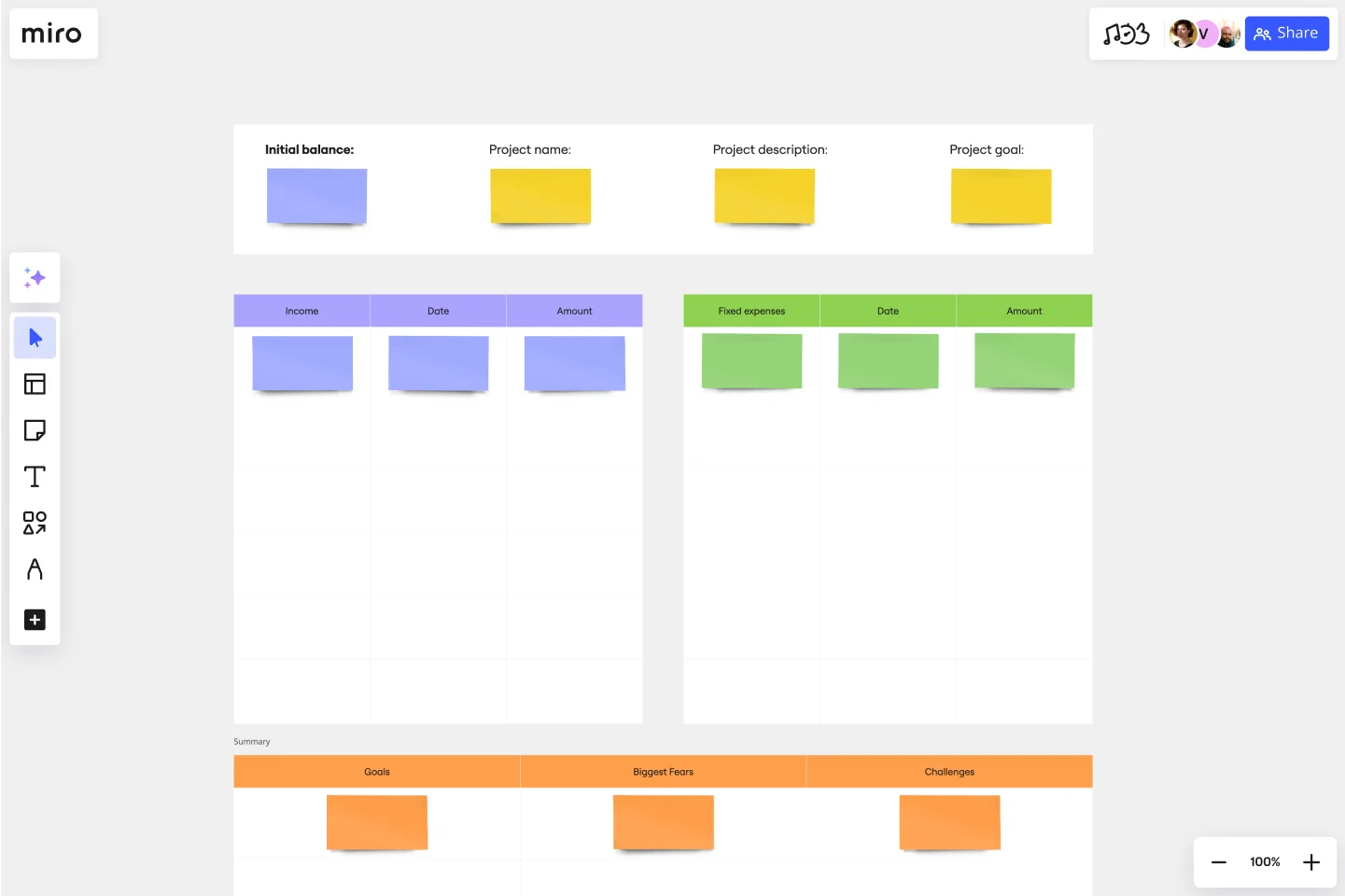Budget Planning Template
Manage all your project’s financial matters more effectively with the Budget Planning Template.
About the Budget Planning Template
The budget planning template lets you manage finances more effectively. It is designed to help you categorize and monitor your financial activities. It can be tailored to your needs and scales, ensuring you can easily monitor expenses.
The template contains the following sections:
Project description: Add relevant details about your current project, such as name, description, and other necessary information.
Project goals: Outlines the financial objectives for a specific project.
Income: It helps you document your income sources.
Fixed expenses: It details your recurring expenses.
Summary: Add any other related goals, concerns, and challenges here.
How to use the budget planning template in Miro
Using a budget planning template is easy and offers a high level of customization. Here's how to use the template:
Fill in the template fields, including project description, goals, income, fixed expenses, date and amount, and summary.
Expand the quadrants by dragging their corners if you need more categories or items.
Customize the template by adding or removing sections to suit your budgeting needs.
Enhance your template with visual aids like graphs or charts to track spending trends.
Collaborate with team members by sharing the link or sending an invitation through the tool you are using.
Why should you use a budget planning template?
Here are some of the key advantages of using a budget template:
Provides a clear overview of your finances: A budget planning template helps you understand your project's financial situation. It allows you to see how much money is coming in and going out so you can make informed decisions about the spending.
Helps you stay on top of expenses: A budget template enables you to track expenses and identify areas where you might be overspending.
Enables you to make informed financial decisions: With a budget template, you can make informed financial decisions based on real data. By tracking spending and income, you'll be better equipped to decide on any of the project’s financial matters.
Can I share the budget template with others?
You can invite team members or stakeholders to view or collaborate on the template by sharing your board link, enhancing transparency and teamwork.
Is it possible to export the data from the template?
Export your budget data to various formats, such as an image or PDF, for further analysis or reporting.
Get started with this template right now.
Opportunity Canvas Template
Works best for:
Leadership, Decision Making, Strategic Planning
Features and capabilities — they make or break a product, which is why companies spend so much time and effort focusing on them. Sound like you? Try it with an Opportunity Canvas. This streamlined one-pager gives you and your team the power to improve your product by exploring the use cases, potential setbacks, strategies, challenges, and metrics. An Opportunity Canvas is ideal if you’ve already built a product, because you don’t need to consider the operational or revenue model.
Bull's Eye Diagram Template
Works best for:
Diagrams, Project Management, Prioritization
When you’re a growing organization, every decision can feel like it has make-or-break consequences—which can lead to decision paralysis, an inability to prioritize, inefficient meetings, and even low morale. If that sounds like you, put a Bull’s Eye Diagram to work. True to its name, a Bull’s Eye Diagram uses a model of concentric circles to help companies establish priorities, make critical decisions, or discuss how to remove or overcome obstacles.
Data Migration Plan Template
Works best for:
Data Migration, Planning
The Data Migration Plan Template is a useful tool for any data migration project, providing a simple and flexible structure. The template outlines the various stages of data migration and can be customized to meet the specific needs of your project. This ensures that the plan remains relevant and effective regardless of the scale or complexity of the migration.
Product Development Phases
The Product Development Phases template assists product teams in managing and tracking product development stages effectively. By defining key phases such as ideation, design, development, and launch, this template provides a structured framework for project planning and execution. With sections for setting milestones, allocating resources, and tracking progress, it enables teams to streamline development processes and drive projects to successful completion. This template serves as a roadmap for navigating the complexities of product development and ensuring timely delivery of high-quality products.
Backlog Refinement with Jira Template
Works best for:
Agile, Backlog Refinement
The Backlog Refinement with Jira template in Miro improves collaboration among team members. It provides a visual and interactive space for teams to review, prioritize, and clarify upcoming work items together in real time. This collaborative approach ensures alignment on priorities and details, leading to a more organized and efficient workflow. The seamless integration with Jira automatically syncs all changes, reducing the need for manual updates and keeping both platforms up-to-date.
Ansoff Matrix Template
Works best for:
Leadership, Operations, Strategic Planning
Keep growing. Keep scaling. Keep finding those new opportunities in new markets—and creative new ways to reach customers there. Sound like your approach? Then this template might be a great fit. An Ansoff Matrix (aka, a product or market expansion grid) is broken into four potential growth strategies: Market Penetration, Market Development, Product Development, and Diversification. When you go through each section with your team, you’ll get a clear view of your options going forward and the potential risks and rewards of each.
